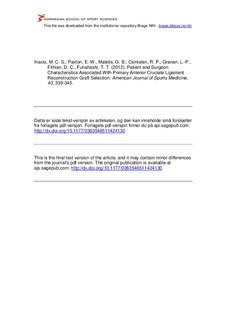Patient and surgeon characteristics associated with primary anterior cruciate ligament reconstruction graft selection
Inacio, Maria C. S.; Paxton, Elisabeth W.; Maletis, Gregory B.; Csintalan, Rick P.; Granan, Lars-Petter; Fithian, Donald C.; Funahashi, Tadashi T.
Journal article, Peer reviewed
Permanent lenke
http://hdl.handle.net/11250/170954Utgivelsesdato
2011-10-05Metadata
Vis full innførselSamlinger
- Artikler / Articles [2120]
Originalversjon
American Journal of Sports Medicine. 2012, 40(2), 339-345Sammendrag
Background: It has been suggested that a surgeon’s experience and training are the most important factors associated with graft selection, but no studies have qualified this association. Graft usage prevalence has not been described for large anterior cruciate ligament reconstruction (ACLR) populations in the United States.
Purpose: To describe the prevalence of graft usage in a large community-based practice and evaluate the association of patient, surgeon, and site characteristics with choice of primary ACLR graft.
Study Design: Cross-sectional study; Level of evidence, 3.
Methods: Primary ACLRs performed between February 2005 and June 2010 were selected for the study. A community-based ligament registry was used to identify cases and variables used for analysis. Graft choice (any allograft, hamstring autograft, and bone–patellar tendon–bone [BPTB] autograft) was compared by patient characteristics and surgeon and site characteristics. Associations between independent variables and graft choice were evaluated using a polychotomous regression model.
Results: Of the 9849 patients included in the study, 64% were male, and overall median age was 28 years. Of these, 2796 (28.4%) received BPTB autografts, 3013 (30.6%) received hamstring autografts, and 4040 (41.0%) received allografts. The prevalence of graft source by patients’ gender, race, age, body mass index (BMI), as well as surgeons’ fellowship training status, average volume, and site volume were significantly different (all P < .001). Adjusted models showed that patients’ gender (P < .001), race (P = .018), age (P < .001), BMI (P < .001), as well as surgeons’ fellowship training status (P < .001), average volume (P < .001), and site volume (P < .001) are associated with graft selection. Older and female patients with lower BMI were more likely to receive allografts and hamstring autografts than BPTB autografts. Cases performed by non–fellowship-trained surgeons, lower volume sites, and/or lower volume surgeons were also more likely to be performed with allografts or hamstring autografts than BPTB autografts.
Conclusion: Gender, age, race, as well as facility and surgeon characteristics such as volume and location are associated with ACL graft choices.
Beskrivelse
I Brage finner du siste tekst-versjon av artikkelen, og den kan inneholde ubetydelige forskjeller fra forlagets pdf-versjon. Forlagets pdf-versjon finner du på ajs.sagepub.com: http://dx.doi.org/10.1177/0363546511424130 / In Brage you'll find the final text version of the article, and it may contain insignificant differences from the journal's pdf version. The original publication is available at ajs.sagepub.com: http://dx.doi.org/10.1177/0363546511424130
